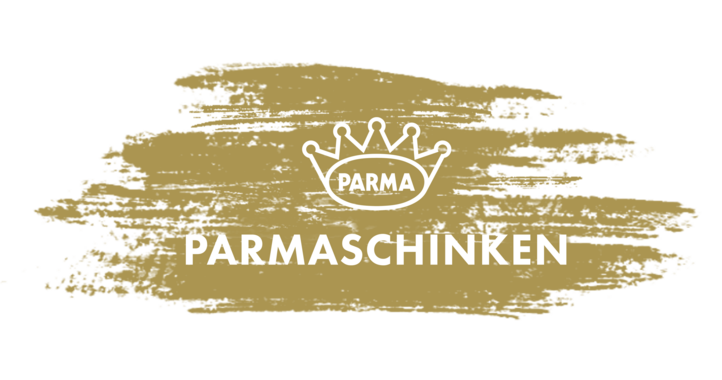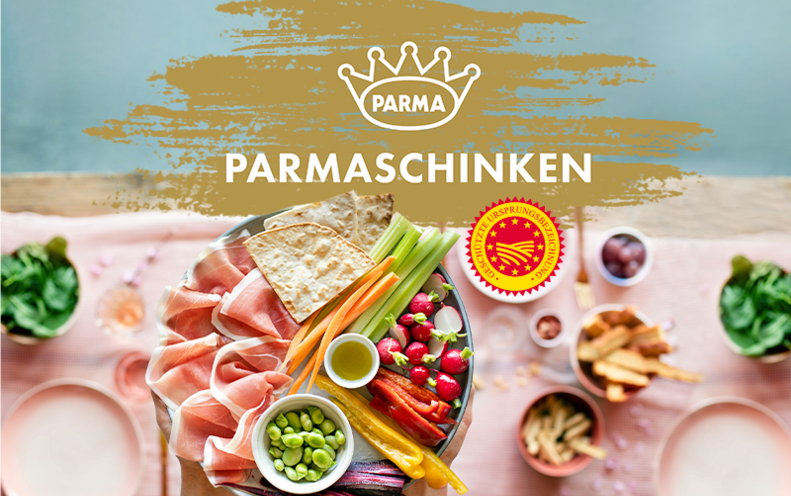Prosciutto di Parma
Prosciutto di Parma specialist - Julius Meinl am Graben
What is Prosciutto di Parma, where does it originate from and what makes it so special? - Dive with us into the world of Parma ham!
Prosciutto di Parma is an Italian air-dried ham. The Italian term prosciutto originally comes from Latin and means dried. Because that is exactly what prosciutto is - a salted and dried ham.According to the legends, this tradition of preserving ham goes back to the time around 100 BC. Even then, ham is said to have been stored in a dry place, matured and thus preserved. The air-dried hams were very popular due to their shelf life and unmistakable aromatic taste and were a valuable commodity throughout the country.

Did you know that Prosciutto di Parma is a protected designation of origin?
Products with the title Prosciutto di Parma may only be produced in the region around Parma and producers must adhere to the strictest quality regulations. Parma ham is 100% natural. It contains no nitrites, nitrates, preservatives or colourings.
To guarantee the authenticity and quality of Prosciutto di Parma, the Consorzio del Prosciutto di Parma was founded in 1963. The aim of this consortium is to preserve and protect the tradition and reputation of Parma ham. At the time of its foundation, 23 producers belonged to the Consorzio; today, this number has more than quintupled with 134 Parma ham producers.
The seal of the Consorzio - the crown of the Dukes of Parma - guarantees the authenticity of Parma ham.
The area of production
As the name "Parma ham" or "Prosciutto di Parma" suggests, the production area of this ham is around the city of Parma. But what makes this region/production area so special?
The world-famous ham is produced in the hills around Parma. The area is bordered to the east and west by the rivers Enza and Stirone. The climatic and geographical conditions are decisive for the consistently high quality of Parma ham. But it is not the area alone that officially makes a Prosciutto di Parma a Prosciutto di Parma. In order to be allowed to display the Consorzio's crown as an official seal of quality on their hams, producers must meet the Consorzio's strict requirements in terms of production and quality.
In Parma, everything revolves around ham. Since 1997, it has even been celebrated at an annual ham festival in the city. Music, good humour, good food and most importantly - the centrepiece of the festival - Parma ham in all its facets. As the absolute highlight of the festival, the producers open their doors and reveal to the visitors the production process of the ham and how climate and traditional craftsmanship affect the quality of the ham.
The production
The production of Prosciutto di Parma is a long process. The pork legs are delivered to the producers exclusively by authorised slaughterhouses.
- There, the 15kg legs are rubbed with sea salt in 2 passes and stored in a cool place for about 3 weeks. The salt serves as the only preservative here! This is what makes Prosciutto di Parma so exceptional.
- In the next step, the legs rest hanging for 70 days at a controlled humidity of 75%.
- To remove the excess salt, the legs are washed and brushed after these 70 days. They then have to dry hanging again for a few days.
- Now the ham is ready for the so-called "pre-drying". This phase of the maturing process is said to be decisive for the aroma of the Parma ham. Suspended on high racks, the hams now dry for several months. During this first drying, the rind-free surface of the Parma ham becomes dry and firm, so it is carefully rubbed with lard and salt to prevent further drying.
- In the seventh month, the ham is ready for the actual air-drying. The hams are taken to the cellar. Here they are exposed to less air and light and can develop their full aroma. The biochemical and enzymatic processes that take place during this phase are crucial for the taste, smell and digestibility of the Parma ham. The ham remains in this cellar until the end of its maturing period. According to legal regulations, Prosciutto di Parma must be matured for at least 1 year (after the first salting). After the quality check, the ham receives the unmistakable brand stamp.


